Retirement is a time when individuals can finally focus on their personal interests and aspirations after years of hard work. A retirement bucket list is a compilation of goals, experiences, and activities that one wishes to accomplish during this phase of life. Having a well-planned bucket list can bring purpose, excitement, and fulfillment to retirees.
Before creating a retirement bucket list, it is essential to take the time to reflect on personal interests and hobbies. Then, consider the activities that bring joy and fulfillment and align with passions and values. Retirement is the perfect time to revisit dreams and aspirations that may have been put on hold due to work and other commitments. Whether it is learning a new skill or visiting a dream destination, these aspirations can form the core of a bucket list. It is crucial to be realistic about skills, capabilities, and any physical or financial limitations that may impact the feasibility of the bucket list items. This will help prioritize and adjust goals accordingly. Once personal goals and desires have been assessed, prioritize them based on importance and feasibility. This will help create a balanced and achievable bucket list. Retirement is a perfect time to engage in lifelong learning and expand knowledge. Enroll in college courses or workshops to learn new subjects or deepen your understanding of an area of interest. Take advantage of online learning platforms to access a wide range of courses and resources. Learn a new language to improve cognitive function and open doors to new cultures and experiences. Retirement provides the time to explore and develop artistic talents and hobbies. Delve into the world of visual arts by taking up painting, photography, or pottery classes. Develop skills and express creativity through various mediums. Pursue a passion for music or dance by taking lessons, joining a choir, or attending dance classes. Enjoy the benefits of artistic expression and physical activity. Engage in hands-on hobbies like gardening or woodworking to stay active, create beautiful spaces, and foster a sense of accomplishment. Giving back to the community can be a fulfilling and enriching aspect of retirement. Support local non-profit organizations by volunteering time, skills, or resources. Make a positive impact on the community and build meaningful connections. Share knowledge and experience by mentoring or teaching others. Inspire and guide the next generation in various fields. Join environmental or social causes that align with personal values and contribute to the betterment of society. Retirement can be an excellent opportunity to explore one's own country. Consider visiting national parks, landmarks, and cities rich in history and culture. Exploring the natural beauty and diversity of national parks and landmarks can be a rewarding experience. Plan trips to iconic parks or lesser-known gems. Road trips offer flexibility and adventure. Plot scenic routes, visit small towns, and enjoy the journey as much as the destination. Immerse yourself in the culture, history, and cuisine of different cities. Attend local events, visit museums, and explore neighborhoods. For those who love to travel, retirement provides ample time to explore the world. Visit iconic tourist sites and marvel at the world's wonders. Explore ancient ruins, famous cities, and architectural marvels. Engage in cultural experiences by staying with local families, participating in traditional activities, and learning about customs and traditions. Discover lesser-known destinations and experience the thrill of uncovering hidden gems. For thrill-seekers, retirement can be an opportunity to engage in adventure activities. Explore the great outdoors through hiking, biking, and camping. Choose trails and locations that suit fitness levels and interests. Dive into water sports like snorkeling, scuba diving, or kayaking. Discover the beauty of marine life and coastal landscapes. Consider trying extreme sports or unique experiences such as skydiving, bungee jumping, or hot air ballooning. Staying active in retirement is essential for overall health and well-being. Participate in regular exercise and sports activities to maintain physical fitness and stay engaged with others. Practice yoga, tai chi, or pilates to improve flexibility, balance, and overall well-being. Challenge oneself by participating in competitive events or races such as marathons or triathlons. Set personal goals and celebrate achievements. Taking care of mental health is just as important as physical fitness during retirement. Incorporate meditation and mindfulness practices into daily routines to reduce stress and improve mental clarity. Consider therapy or support groups to address emotional needs, build connections, and foster personal growth. Explore and adopt stress reduction techniques, such as deep breathing, visualization, or journaling, to maintain mental well-being. Retirement offers the chance to focus on nutrition and healthy living habits. Take cooking classes to learn new recipes and techniques or plan healthy meals to improve overall nutrition. Grow fruits, vegetables, or herbs in a home garden to enjoy fresh, organic produce and contribute to sustainable living. Experiment with different dietary preferences and restrictions to find the optimal nutrition plan for individual health needs. Retirement is a prime time to focus on nurturing existing relationships. Plan family vacations or reunions to spend quality time with loved ones and create lasting memories. Take the opportunity to visit friends and loved ones, strengthening connections and enjoying shared experiences. Organize regular gatherings and events to foster social bonds and maintain a sense of community. Retirement is also an excellent time to make new friends and expand social networks. Join clubs, interest groups, or social organizations to meet like-minded individuals and participate in shared activities. Engage in community events to build connections, learn about local happenings, and contribute to the community's vibrancy. Attend workshops, conferences, or seminars to meet new people, expand your knowledge, and stay engaged with current trends. Retirement is a time when individuals can finally focus on their personal interests and aspirations after years of hard work. A retirement bucket list is a compilation of goals, experiences, and activities that one wishes to accomplish during this phase of life. Before creating a retirement bucket list, it is essential to take the time to reflect on personal interests and hobbies, consider long-standing dreams and aspirations, evaluate skills, capabilities, and limitations, and prioritize goals based on importance and feasibility. Retirement offers the chance to engage in lifelong learning, expand knowledge, develop artistic talents, pursue a passion for music or dance, engage in hands-on hobbies, give back to the community, and join social organizations. It also provides ample time to travel the world, explore national parks and landmarks, immerse in cultural experiences, and participate in adventure activities. Retirement is a prime time to focus on nurturing existing relationships, planning family vacations or reunions, visiting friends and loved ones, and making new connections through clubs, interest groups, and community events.Retirement Bucket List Overview
Assessing Personal Goals and Desires for Retirement Bucket List
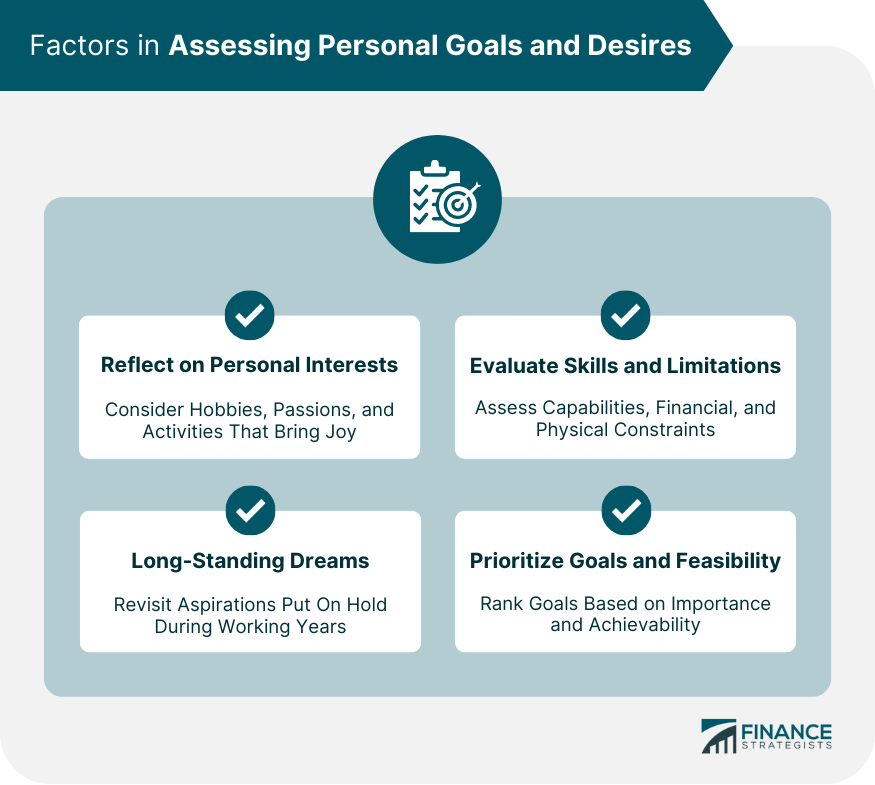
Reflect on Personal Interests and Hobbies
Consider Long-Standing Dreams and Aspirations
Evaluate Skills, Capabilities, and Limitations
Prioritize Goals Based on Importance and Feasibility
Personal Growth and Learning for Retirement Bucket List
Educational Pursuits
College Courses and Workshops
Online Learning Platforms
Language Learning
Arts and Hobbies
Painting, Photography, or Pottery
Music and Dance Lessons
Gardening or Woodworking
Volunteer Work and Community Involvement
Local Non-Profit Organizations
Mentorship and Teaching Opportunities
Environmental and Social Causes
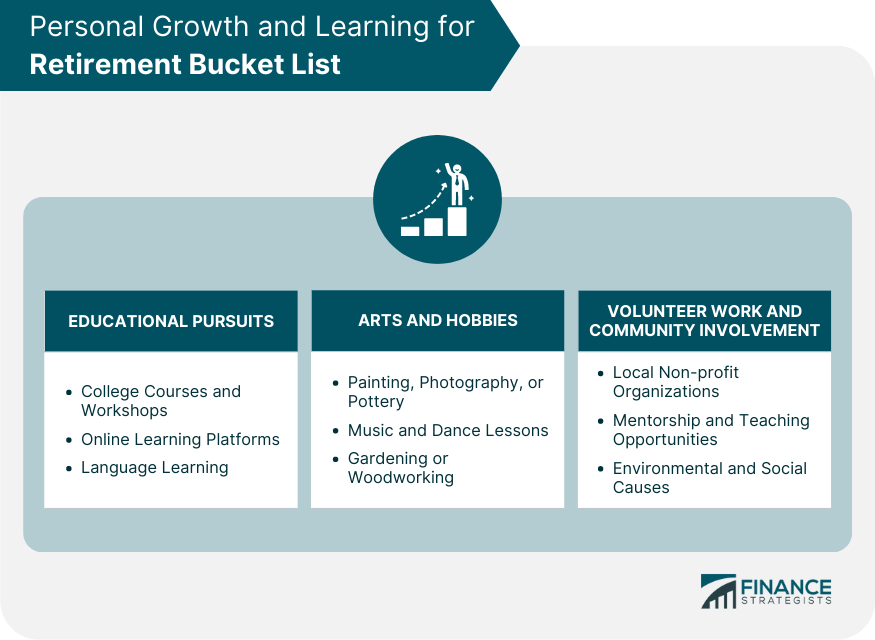
Travel and Adventure for Retirement Bucket List
Domestic Destinations
National Parks and Landmarks
Road Trips and Scenic Routes
Cities and Cultural Attractions
International Destinations
Popular Tourist Sites
Cultural Immersion Experiences
Off-the-Beaten-Path Locations
Adventure Activities
Hiking, Biking, and Camping
Water Sports and Ocean Exploration
Extreme Sports and Unique Experiences
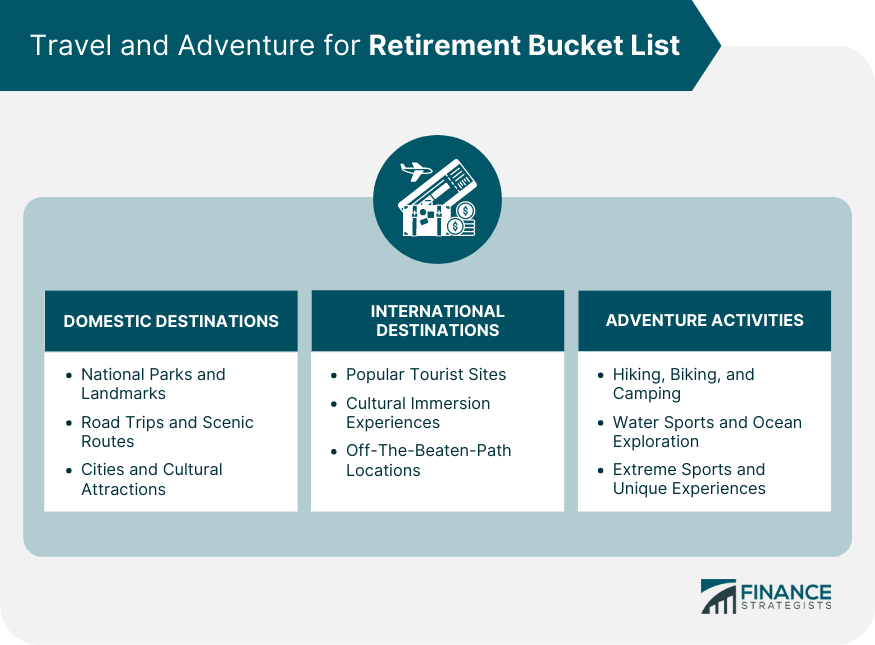
Health and Wellness for Retirement Bucket List
Physical Fitness
Exercise and Sports Activities
Yoga, Tai Chi, or Pilates
Competitive Events or Races
Mental Well-Being
Meditation and Mindfulness Practices
Therapy and Support Groups
Stress Reduction Techniques
Nutrition and Healthy Living
Cooking Classes and Meal Planning
Gardening and Sustainable Living
Exploring Dietary Preferences and Restrictions
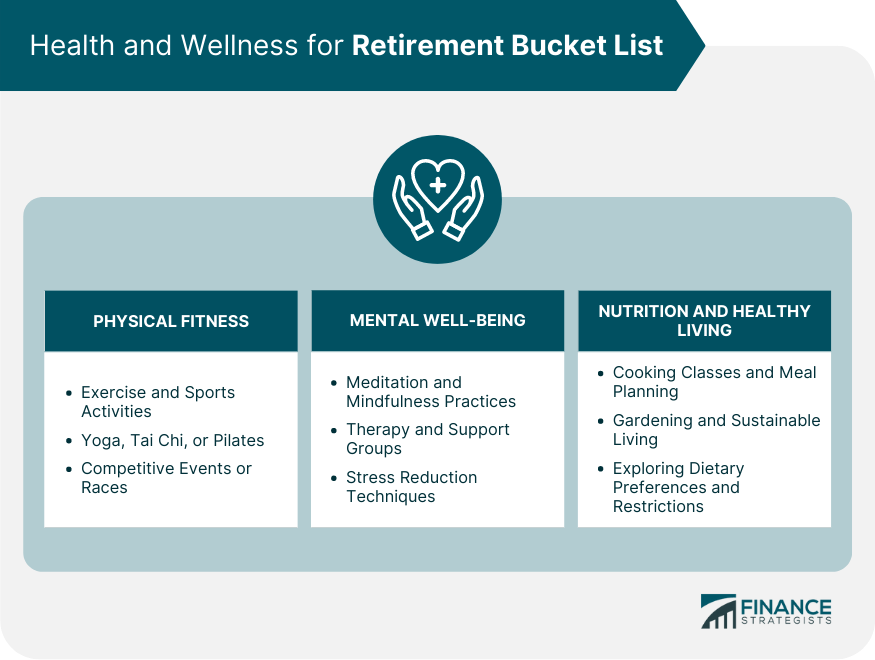
Social and Family Connections for Retirement Bucket List
Strengthening Relationships
Family Vacations and Reunions
Visiting Friends and Loved Ones
Regular Gatherings and Events
Making New Connections
Join Clubs or Interest Groups
Participate in Community Events
Attend Workshops and Conferences
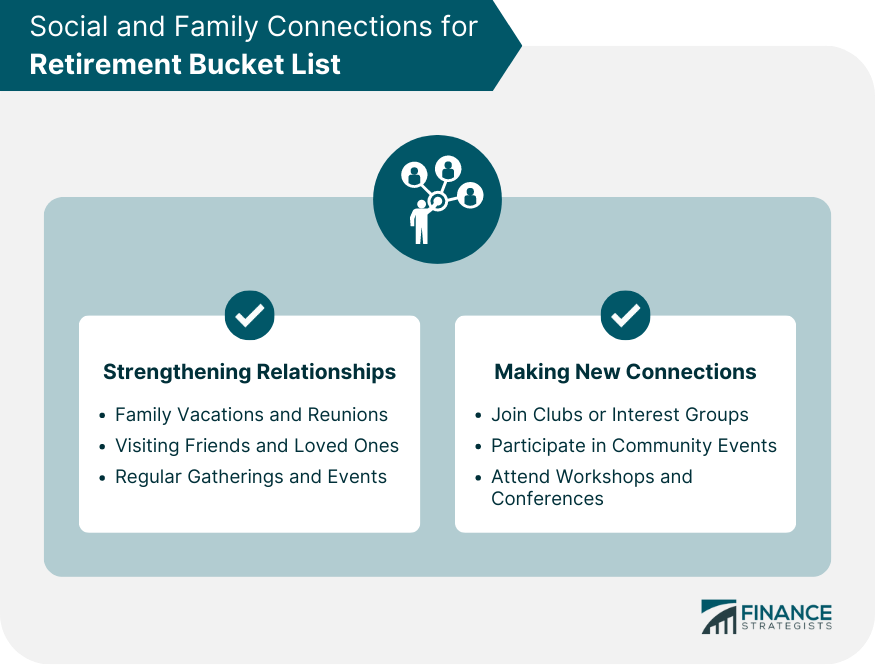
Final Thoughts
Retirement Bucket List FAQs
A retirement bucket list is a collection of goals, experiences, and activities that individuals wish to accomplish during their retirement years. It is important because it brings purpose, excitement, and fulfillment to retirees, helping them make the most of their newfound freedom.
To create a personalized retirement bucket list, start by reflecting on your interests, hobbies, long-standing dreams, and aspirations. Evaluate your skills, capabilities, and limitations, and prioritize goals based on importance and feasibility. This will help you design a bucket list that truly aligns with your passions and values.
Popular travel destinations for a retirement bucket list may include domestic locations such as national parks, landmarks, and cultural attractions, as well as international destinations like iconic tourist sites and culturally immersive experiences. Adventure activities can encompass hiking, biking, camping, water sports, ocean exploration, and even extreme sports or unique experiences.
Incorporate personal growth and learning into your retirement bucket list by exploring educational pursuits like college courses, workshops, and online learning platforms. Engage in arts and hobbies such as painting, photography, or gardening, and consider volunteering or participating in community involvement to support causes that align with your values.
To maintain health and wellness while pursuing your retirement bucket list, focus on physical fitness by engaging in regular exercise, sports activities, or practices like yoga and tai chi. Prioritize mental well-being through meditation, mindfulness practices, therapy, or support groups, and emphasize nutrition and healthy living by cooking nutritious meals, gardening, and exploring dietary preferences or restrictions.
True Tamplin is a published author, public speaker, CEO of UpDigital, and founder of Finance Strategists.
True is a Certified Educator in Personal Finance (CEPF®), author of The Handy Financial Ratios Guide, a member of the Society for Advancing Business Editing and Writing, contributes to his financial education site, Finance Strategists, and has spoken to various financial communities such as the CFA Institute, as well as university students like his Alma mater, Biola University, where he received a bachelor of science in business and data analytics.
To learn more about True, visit his personal website or view his author profiles on Amazon, Nasdaq and Forbes.











